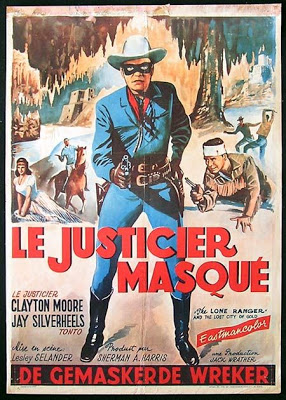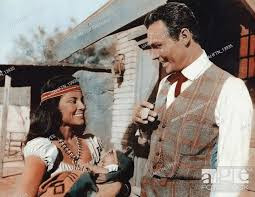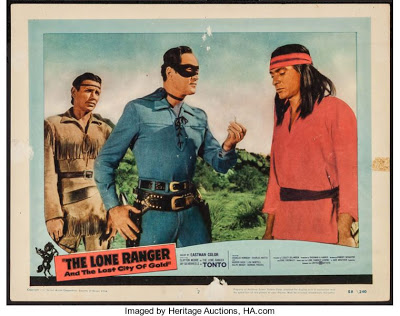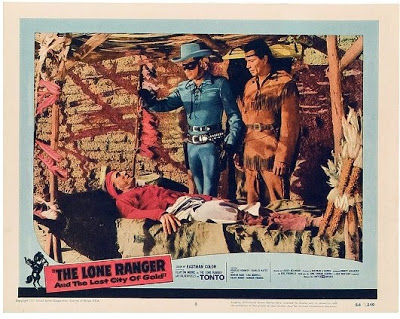The things from our childhood stick to us
years later in mysterious ways. Much more so I think than things that come
later as adults. Nostalgia certainly plays a part of it but I think it goes
deeper than that. Maybe it is because these were the first things we watched
or listened to or read and our developing brain captured them and kept them
like amber trapping ancient objects. We were also much more innocent then
and good and bad seemed simpler. The Lone Ranger was a huge part of my TV
watching time back in the early 60s with the show being shown in the afternoon
after school. The thrilling beginning of the William Tell Overture and the
Lone Ranger speeding across the plains, guns out and a hearty Hi-Yo-Silver
never failed to make me tingle. Well that was a lot of years ago and I was
curious how I would react now, somewhat less innocent.
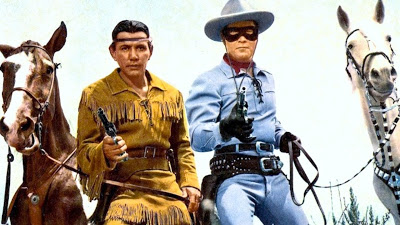
The Lone Ranger was around for a long time - it was part of the culture back
then. It began first on radio in 1933 and went for nearly 3,000 shows. Republic
produced two serials of the masked man and his compadre Tonto. But for most
of us it was the TV show that ran from 1949 to 1957 with 221 episodes that
we remember. With Clayton Moore as the Lone Ranger and Jay Silverheels as
Tonto. Moore had been around making films for about ten years before he took
on the TV show - mainly in B Westerns where you can see his face. I came
across one of these a while ago and didn't initially recognize him till he
spoke and then like some Pavlovian memory dredged up I knew immediately who
he was.
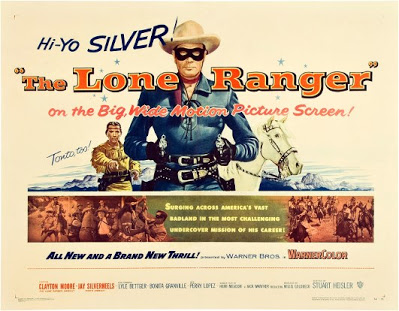
There were two films with him made that showed theatrically - this one and
The Lone Ranger and the City of Gold. After the second film Moore retired
from film but not from the Lone Ranger. He was to go around for years making
paid appearances as the Ranger - was sued to stop at one point - wore sunglasses
in place of his mask and then won the right to be the Lone Ranger again.
Jay Silverheels was a real Native American Mohawk born on a reservation in
Canada. He began in show business as a stuntman and then bit parts before
he was offered this role. He continued acting in TV and film until the mid-70s.
He was later to receive a lot of criticism by Native American rights groups
for playing this role and was called an "Uncle Tomahawk".
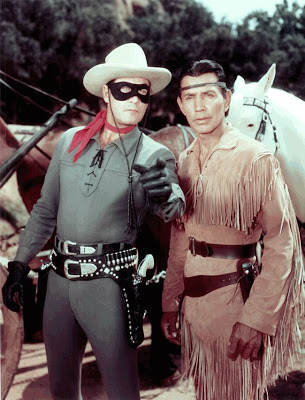
The film does not sadly begin in the same manner as the TV show though we
get the William Tell - but it does end the same way as the two of them slip
away, jump on their horses and ride with someone behind saying who was that
masked man. That was the Lone Ranger. This is actually not too bad. I didn't
feel embarrassed watching it as I did a while ago when I thought it would
be fun to read a Hardy Boys book - that was bad. This is shot in beautiful
color, well produced, great landscapes, some great scenes of horses racing
across the land and at the end a few nifty stunts by someone - not likely
Clayton Moore. It is a story that has been told in a 100 B Westers. White
men working for a wealthy rancher who wants to drive the Native Americans
off their reservation stirs up a war by having his men dress up as natives
and burn and kill. It is up to our heroes to stop him and stop a war.
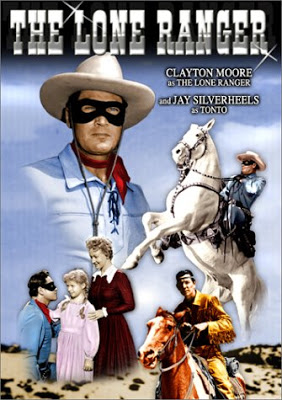
In the cast of note are also Bonita Granville (Nancy Drew in those earlier
films). Michael Ansara once again gets to play a Native American -
as he did as Cochise in the TV show Broken Arrow which ran from 1956 to 1958
(he was born in Syria) and Robert Wilke whose name you may not recognize
but you would his face as he played bad guys in Westerns all the time - High
Noon perhaps his most famous as one of the men who comes gunning for Gary
Cooper. So ya, I did enjoy this and feel like watching the other one. I am
a product of my youth.
The Lone Ranger
and the Lost City of Gold
Director: Lesley Selander
Year: 1956
Rating: 6.0
This one begins in song about the origin story
of the Lone Ranger. He was a Texas Ranger under the command of his brother
and when they are betrayed five of them are killed with only the Lone Ranger
surviving. Tonto comes along and nurses him back to health and the Lone Ranger
makes a mask out of his brother's shirt and begins his crusade to bring justice
to the west! But why the mask? It makes no sense. It isn't as if he is leading
a double life like Zorro or Batman where his identity has to be hidden. He
is always the Lone Ranger out there somewhere waiting for trouble to show
up. It is not like he could take the mask off and go home. He has no home.
No social life. No babes. Only Tonto. And the mask just causes confusion.
Everyone he meets seems to initially think he is a robber and he has to go
through the explanation that the mask represents justice. How? Why? And the
few times he takes the mask off so that he can mingle with the town folk
he puts on a disguise on - usually as a cranky old prospector. Just
one of those questions that has been nagging at me since childhood.
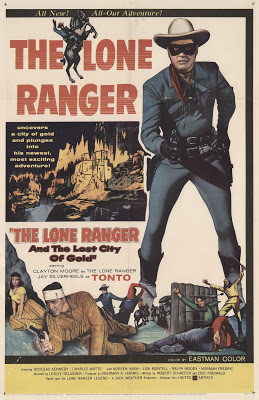
This was the second theatrical film of the Lone Ranger released two years
after the first and pretty much the end of Clayton Moore's career. I don't
know why. He was only 44 years old but perhaps he felt so identified as the
Lone Ranger that when the TV show ended he just decided to hang up his spurs.
At least on the screen. He once said that he loved the character of the Lone
Ranger so much that he tried to emulate him and continued as him at public
events for years to come. A little weird.
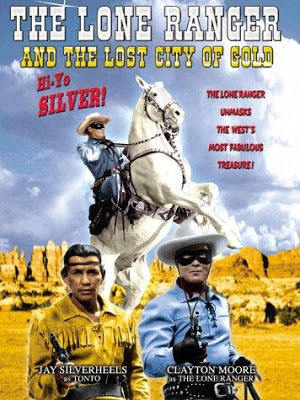
This is a solid Western that falls somewhere between B and A - good production
values like the first, shot in lovely color in great locations - but a plot
that feels B all the way. A few Native Americans have been killed by a band
of hooded men and no one has any idea why - sort of serial killings and no
one can figure out the connection. Till the Lone Ranger and Tonto get on
the case. They discover that all the murdered men had a medallion around
their neck that was stolen. Five pieces of it exist and it is a map to the
City of Gold that the Spaniards discovered 200 years before. The film sludges
along for the first half but has a good ending in which the gang is hunting
down the last medallion in a native village and get gunned down one by one
by the Lone Ranger and Tonto. In the TV series I don't recall him ever killing
anyone - just shooting the gun out of their hand - but here neither of them
hesitates.
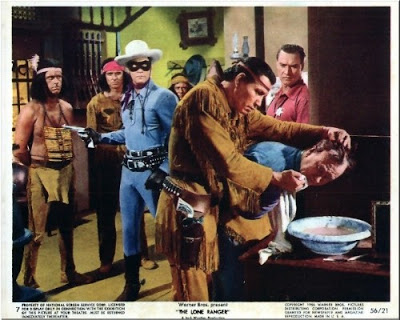
Tonto is as much the hero of this one as the Lone Ranger - maybe more so
- and Silver who discovers a baby and communicates this to the Lone Ranger
in Morse code by stamping on the ground. Baby here. Don't leave you idiot.
I was worried this was going to turn into Two Men, a Horse and a Baby. And
poor Tonto - every time the Lone Ranger tells him to go into town to spy
you know they are going to beat the hell out of him for being a "redskin".
If I were Tonto, I would say no. Please not again.
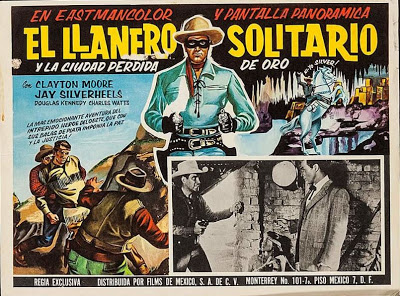
They discover the City of Gold on the reservation and it turns out to be
a casino. Just kidding - it is a vast amount of gold and the Indians say
- and it is on our land and I thought - not for long once the White Man hears
about it. These days I am a little leery about Westerns because of how they
often portray Native Americans - I know they were made a long time ago but
still I find it hard to root for the White Man like I did as a kid. Fortunately,
both these films portray the Native Americans very positively and the white
men and their prejudices very negatively. In fact, one of the subplots has
to do with the town doctor (Dean Fredericks) passing for white though he
is the grandson of the chief. And the Native American woman (the lovely Lisa
Montell) ashamed of him for doing so. For Lisa Montell he does come out and
who could blame him.
